Xuantang Xiong
Cross-Task Experiential Learning on LLM-based Multi-Agent Collaboration
May 29, 2025Abstract:Large Language Model-based multi-agent systems (MAS) have shown remarkable progress in solving complex tasks through collaborative reasoning and inter-agent critique. However, existing approaches typically treat each task in isolation, resulting in redundant computations and limited generalization across structurally similar tasks. To address this, we introduce multi-agent cross-task experiential learning (MAEL), a novel framework that endows LLM-driven agents with explicit cross-task learning and experience accumulation. We model the task-solving workflow on a graph-structured multi-agent collaboration network, where agents propagate information and coordinate via explicit connectivity. During the experiential learning phase, we quantify the quality for each step in the task-solving workflow and store the resulting rewards along with the corresponding inputs and outputs into each agent's individual experience pool. During inference, agents retrieve high-reward, task-relevant experiences as few-shot examples to enhance the effectiveness of each reasoning step, thereby enabling more accurate and efficient multi-agent collaboration. Experimental results on diverse datasets demonstrate that MAEL empowers agents to learn from prior task experiences effectively-achieving faster convergence and producing higher-quality solutions on current tasks.
Co-Saving: Resource Aware Multi-Agent Collaboration for Software Development
May 28, 2025Abstract:Recent advancements in Large Language Models (LLMs) and autonomous agents have demonstrated remarkable capabilities across various domains. However, standalone agents frequently encounter limitations when handling complex tasks that demand extensive interactions and substantial computational resources. Although Multi-Agent Systems (MAS) alleviate some of these limitations through collaborative mechanisms like task decomposition, iterative communication, and role specialization, they typically remain resource-unaware, incurring significant inefficiencies due to high token consumption and excessive execution time. To address these limitations, we propose a resource-aware multi-agent system -- Co-Saving (meaning that multiple agents collaboratively engage in resource-saving activities), which leverages experiential knowledge to enhance operational efficiency and solution quality. Our key innovation is the introduction of "shortcuts" -- instructional transitions learned from historically successful trajectories -- which allows to bypass redundant reasoning agents and expedite the collective problem-solving process. Experiments for software development tasks demonstrate significant advantages over existing methods. Specifically, compared to the state-of-the-art MAS ChatDev, our method achieves an average reduction of 50.85% in token usage, and improves the overall code quality by 10.06%.
Multi-Agent Collaboration via Evolving Orchestration
May 26, 2025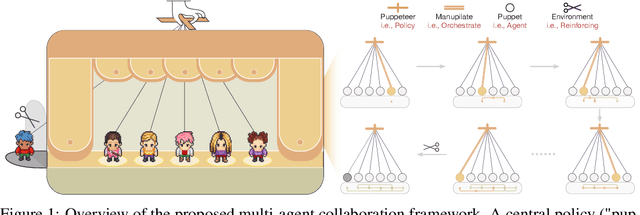


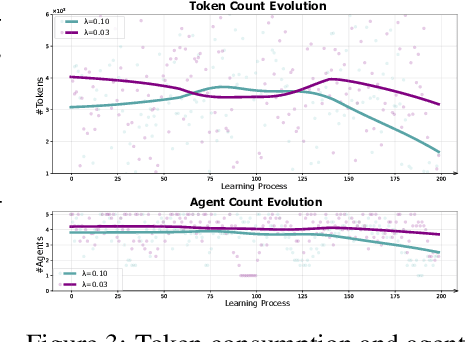
Abstract:Large language models (LLMs) have achieved remarkable results across diverse downstream tasks, but their monolithic nature restricts scalability and efficiency in complex problem-solving. While recent research explores multi-agent collaboration among LLMs, most approaches rely on static organizational structures that struggle to adapt as task complexity and agent numbers grow, resulting in coordination overhead and inefficiencies. To this end, we propose a puppeteer-style paradigm for LLM-based multi-agent collaboration, where a centralized orchestrator ("puppeteer") dynamically directs agents ("puppets") in response to evolving task states. This orchestrator is trained via reinforcement learning to adaptively sequence and prioritize agents, enabling flexible and evolvable collective reasoning. Experiments on closed- and open-domain scenarios show that this method achieves superior performance with reduced computational costs. Analyses further reveal that the key improvements consistently stem from the emergence of more compact, cyclic reasoning structures under the orchestrator's evolution.
GLTW: Joint Improved Graph Transformer and LLM via Three-Word Language for Knowledge Graph Completion
Feb 17, 2025Abstract:Knowledge Graph Completion (KGC), which aims to infer missing or incomplete facts, is a crucial task for KGs. However, integrating the vital structural information of KGs into Large Language Models (LLMs) and outputting predictions deterministically remains challenging. To address this, we propose a new method called GLTW, which encodes the structural information of KGs and merges it with LLMs to enhance KGC performance. Specifically, we introduce an improved Graph Transformer (iGT) that effectively encodes subgraphs with both local and global structural information and inherits the characteristics of language model, bypassing training from scratch. Also, we develop a subgraph-based multi-classification training objective, using all entities within KG as classification objects, to boost learning efficiency.Importantly, we combine iGT with an LLM that takes KG language prompts as input.Our extensive experiments on various KG datasets show that GLTW achieves significant performance gains compared to SOTA baselines.
GuideLight: "Industrial Solution" Guidance for More Practical Traffic Signal Control Agents
Jul 15, 2024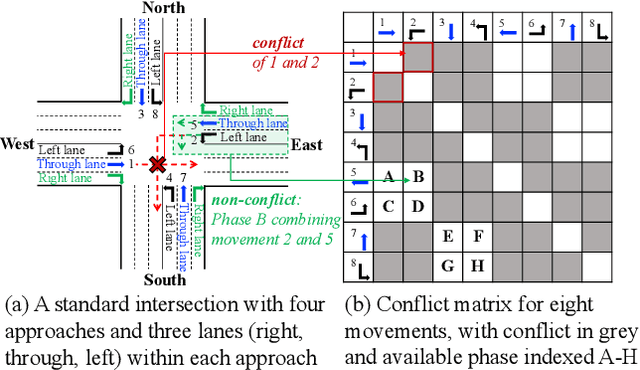
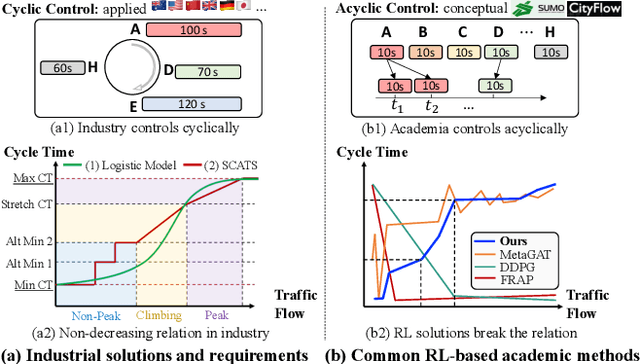
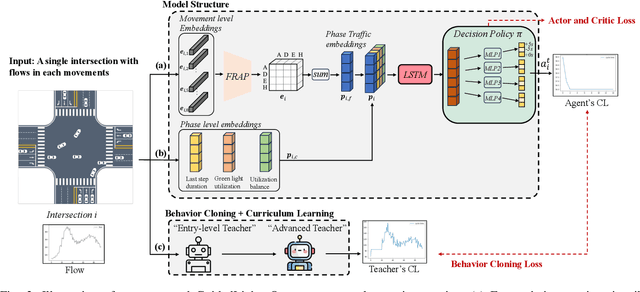

Abstract:Currently, traffic signal control (TSC) methods based on reinforcement learning (RL) have proven superior to traditional methods. However, most RL methods face difficulties when applied in the real world due to three factors: input, output, and the cycle-flow relation. The industry's observable input is much more limited than simulation-based RL methods. For real-world solutions, only flow can be reliably collected, whereas common RL methods need more. For the output action, most RL methods focus on acyclic control, which real-world signal controllers do not support. Most importantly, industry standards require a consistent cycle-flow relationship: non-decreasing and different response strategies for low, medium, and high-level flows, which is ignored by the RL methods. To narrow the gap between RL methods and industry standards, we innovatively propose to use industry solutions to guide the RL agent. Specifically, we design behavior cloning and curriculum learning to guide the agent to mimic and meet industry requirements and, at the same time, leverage the power of exploration and exploitation in RL for better performance. We theoretically prove that such guidance can largely decrease the sample complexity to polynomials in the horizon when searching for an optimal policy. Our rigid experiments show that our method has good cycle-flow relation and superior performance.
CoSLight: Co-optimizing Collaborator Selection and Decision-making to Enhance Traffic Signal Control
May 27, 2024Abstract:Effective multi-intersection collaboration is pivotal for reinforcement-learning-based traffic signal control to alleviate congestion. Existing work mainly chooses neighboring intersections as collaborators. However, quite an amount of congestion, even some wide-range congestion, is caused by non-neighbors failing to collaborate. To address these issues, we propose to separate the collaborator selection as a second policy to be learned, concurrently being updated with the original signal-controlling policy. Specifically, the selection policy in real-time adaptively selects the best teammates according to phase- and intersection-level features. Empirical results on both synthetic and real-world datasets provide robust validation for the superiority of our approach, offering significant improvements over existing state-of-the-art methods. The code is available at https://github.com/AnonymousAccountss/CoSLight.
X-Light: Cross-City Traffic Signal Control Using Transformer on Transformer as Meta Multi-Agent Reinforcement Learner
Apr 18, 2024



Abstract:The effectiveness of traffic light control has been significantly improved by current reinforcement learning-based approaches via better cooperation among multiple traffic lights. However, a persisting issue remains: how to obtain a multi-agent traffic signal control algorithm with remarkable transferability across diverse cities? In this paper, we propose a Transformer on Transformer (TonT) model for cross-city meta multi-agent traffic signal control, named as X-Light: We input the full Markov Decision Process trajectories, and the Lower Transformer aggregates the states, actions, rewards among the target intersection and its neighbors within a city, and the Upper Transformer learns the general decision trajectories across different cities. This dual-level approach bolsters the model's robust generalization and transferability. Notably, when directly transferring to unseen scenarios, ours surpasses all baseline methods with +7.91% on average, and even +16.3% in some cases, yielding the best results.
Balancing Exploration and Exploitation in Hierarchical Reinforcement Learning via Latent Landmark Graphs
Jul 22, 2023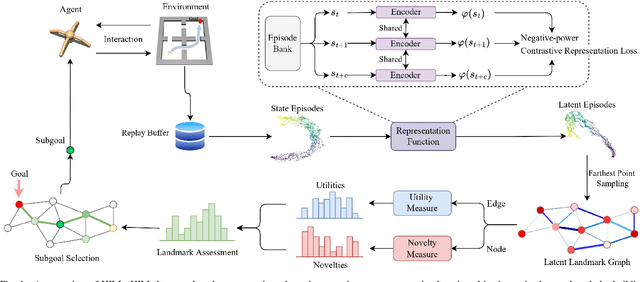

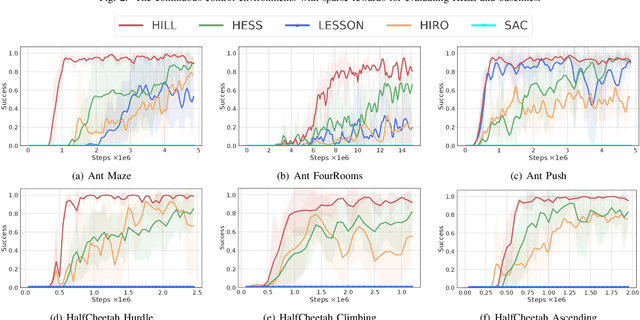
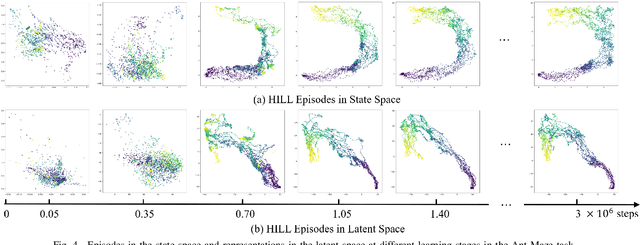
Abstract:Goal-Conditioned Hierarchical Reinforcement Learning (GCHRL) is a promising paradigm to address the exploration-exploitation dilemma in reinforcement learning. It decomposes the source task into subgoal conditional subtasks and conducts exploration and exploitation in the subgoal space. The effectiveness of GCHRL heavily relies on subgoal representation functions and subgoal selection strategy. However, existing works often overlook the temporal coherence in GCHRL when learning latent subgoal representations and lack an efficient subgoal selection strategy that balances exploration and exploitation. This paper proposes HIerarchical reinforcement learning via dynamically building Latent Landmark graphs (HILL) to overcome these limitations. HILL learns latent subgoal representations that satisfy temporal coherence using a contrastive representation learning objective. Based on these representations, HILL dynamically builds latent landmark graphs and employs a novelty measure on nodes and a utility measure on edges. Finally, HILL develops a subgoal selection strategy that balances exploration and exploitation by jointly considering both measures. Experimental results demonstrate that HILL outperforms state-of-the-art baselines on continuous control tasks with sparse rewards in sample efficiency and asymptotic performance. Our code is available at https://github.com/papercode2022/HILL.
 Add to Chrome
Add to Chrome Add to Firefox
Add to Firefox Add to Edge
Add to Edge